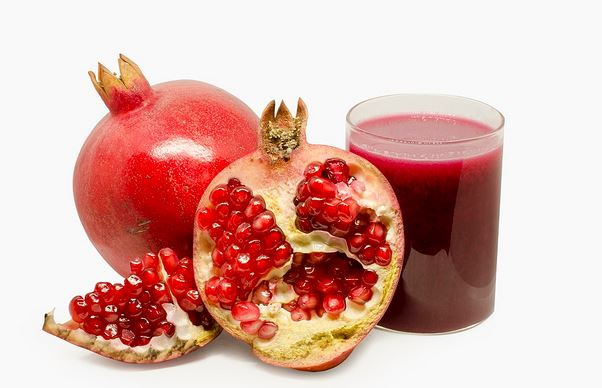Pomegranate and other superfoods that fight inflammation
The University of California, Davis has studied pomegranate juice and its health benefits for the heart, blood, and cardiovascular system. See the study results in “Antioxidant Activity of Pomegranate Juice and Its Relationship with Phenolic Composition and Processing.” The reason why pomegranates or pomegranate extract and juice is listed as a super food is that pomegranates may slow artery hardening and reduce cholesterol levels. See the February, 2007 Life Extension Magazine article, “Pomegranate Reverses Atherosclerosis and Slows the Progression of Prostate Cancer.”
Pomegranate is also called a superfood because it enhances nitric oxide, improves endothelial function, and protects cardiovascular health. By augmenting nitric oxide, it supports the functioning of endothelial cells that line the arterial walls. Vascular smooth muscle is signaled to relax by Nitric Oxide, thereby increasing blood flow through arteries and veins.
It also reduces injury to the vessel walls, which also helps prevent the development of atherosclerosis, according to another study. “Nitric oxide as a signaling molecule in the vascular system: an overview,” Cardiovascular Pharmacology. 1999 Dec;34(6):879-86. Authors are Ignarro LJ, Cirino G, Casini A, Napoli C. J.
Which Super Foods are Healthiest?
Some nuts are also considered a superfood. A handful, not a can, of walnuts nuts can thin your blood. You can look up the study where 20 men and women ate 8 to 13 walnuts a day to improve blood flow by making your arteries more elastic. This information appears on page 139 of the book, Superfoods for Seniors, by the editors of FC&A Medical Publishing. Unfortunately, the chapters on super foods mention the results of studies but never include footnotes giving the name of the study or where it can be read.
Other studies included in this book of super foods include wild-caught salmon, oranges, asparagus as a way to get folate (one of the B vitamins), and other foods such as avocados, cauliflower, Brussels sprouts, bananas, blueberries, brown rice, carrots, cranberries, pomegranate juice, and olive oil–all as super foods.
The book also lists the vitamin C content of sweet red peppers, which are high in vitamin C with 226 mg for one medium sweet red bell pepper. But if you feel arthritis pain after eating nightshade vegetables such as peppers, tomatoes, and potatoes, you can get your vitamin C from other fruits or vegetables.
Next highest on the list is the papaya with 188 mg of vitamin C. Other foods mentioned that you’d eat for their vitamin C content include cranberry juice, broccoli, strawberries, Brussels sprouts, green pepper, orange juice, kiwi fruit, or a whole orange. Orange juice contains 82 mg of vitamin C in one cup. Eating a whole medium orange for the fiber gives you only 70 mg of vitamin C.
Other super foods used for their ability to cut inflammation or to thin the blood
Green tea reduces viscosity. It’s the theanine, an amino acid in green tea that makes blood less sticky or viscous. People who consume the most vegetables, fruits and green tea have a good chance of avoiding blood clots. Unless they have a genetic variation that makes them grow clots as a possible reaction to adaptation to cereal grains. That is open to further study and between you and your health care team.
As for dried fruits which are high in sugar, figs have a lot of fiber, potassium, and magnesium. In moderation they are considered a healthy super food. What may be helpful is to emphasize nutrient-rich vegetables and fruits for their antioxidant values. But eat portions in moderation so you don’t get too many high blood sugar/glucose spikes from eating too much fruit at one sitting. As far as folate, spinach helps, and spinach also contains magnesium.
One cup of spinach supplies you with a healthy amount of magnesium. And pomegranate juice helps improve blood flow in some people, according to a University of California study. According to epidemiological studies at UC Davis, consumption of fruits and vegetables with high phenolic content correlate with reduced cardio- and cerebrovascular diseases and cancer mortality (Hertog et al., 1997).
Phenolic compounds in Pomegranate may produce their beneficial effects by scavenging free radicals
In the past few years there has been an increasing interest in determining relevant dietary sources of antioxidant phenolics. Red and purple fruit juices such as grape and different berry juices have received attention due to their antioxidant activity.
Pomegranate juice has become more popular because of the attribution of important biological actions (Lansky et al., 1998). Thus, the antioxidant and antitumoral activity of pomegranate bark tannins (punicacortein) (Kashiwada et al., 1992; Su et al., 1988) and the antioxidant activity of the fermented pomegranate juice (Schubert et al., 1999) have been reported. However, detailed investigations of the phenolic compounds and the antioxidant activity of the juice have not yet been carried out.
Pomegranate bark tannins (punicacortein) (Kashiwada et al., 1992; Su et al., 1988) and the antioxidant activity of the fermented pomegranate juice (Schubert et al., 1999) have been reported. However, detailed investigations of the phenolic compounds and the antioxidant activity of the juice have not yet been carried out. Pomegranate juice is an important source of anthocyanins, and the 3-glucosides and 3,5-diglucosides of delphinidin, cyanidin, and pelargonidin have been reported (Du et al., 1975). So along with other fruits and vegetables, pomegranate eaten in moderation, is also called by many, a super food.
Fiber and Barley as Super Foods
Some people do not get enough fiber. It is suggested that a healthy diet should include about 15-35 grams of fiber daily. However, men need more fiber than women. So perhaps some women need around 25 grams of fiber compared to 35 for some men to maintain weight and stay healthy. Fiber, in moderation, is also called a super food. But eat the fiber as part of the food. For example, red raspberries are higher in fiber than strawberries. And apples provide good fiber, but are also high in fructose. So, choose what you eat for fiber in moderation. The amount of fiber you eat is an individual issue and depends on other factors.
Other studies report you might be able to slash your colon cancer risk by 40 percent by eating some barley. Soluble fiber found in oat bran or barley may react with the organisms in your large intestine to prevent constipation and perhaps protect against colon cancer. Don’t use the white, pearled barley. Use the tan-colored lightly pearled barley that’s similar in color to brown rice.
Pomegranate and the other superfoods
These superfoods all have shown promise dealing with inflammation. The key is to identify which most fit your dietary needs based on your personal diet plan. If there is some confusion you can always seek the advice of a functional nutritionist or simply go see your primary care doctor.



